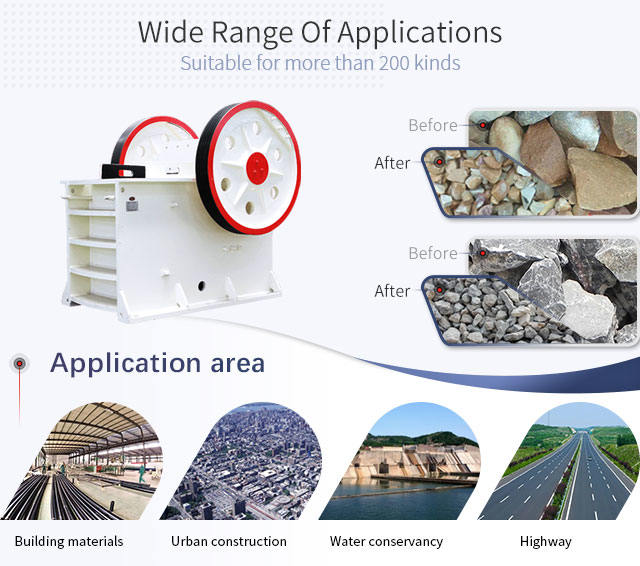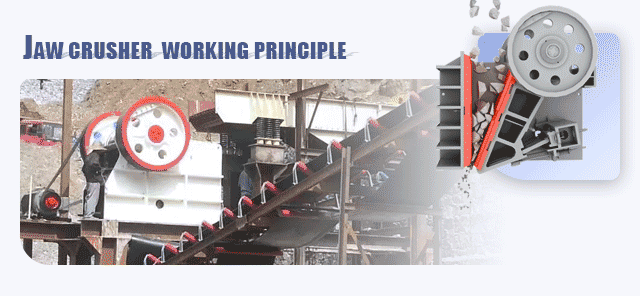The jaw crusher is mainly composed of a frame, a movable jaw assembly, a movable jaw, a fixed jaw, a triangular wheel, a flywheel, a bracket, a side guard, a discharge port adjusting device and a driving device. Because of its simple structure, easy manufacture, reliable operation and convenient maintenance, it has been widely used in crushing operations in metallurgy, chemical industry and mining industries.

The material is crushed between the two jaws, so the wear of the liner is the main problem of the jaw crusher. And the types of wear and tear are mainly divided into the following cases.

Bruise wear
In the jaw crusher, the ore is crushed and reduced to the required particle size. When the moving plate moves away from the fixed plate, the ore is sliding down freely from the upper portion of the crushing chamber to the discharge port under the action of gravity. During this process, the ore slides down along the surface of the jaw plate and causes sliding friction which makes the jaw plate be worn. Therefore, the abrasive wear is an important wear type caused by the squeezed ore.
Chiseling wear
When the ore is squeezed and ground under the huge mechanical force of the jaw plate, it is easy to form hard sharp edges and corners, and continual interaction between ore and the jaw plate makes the surface of the jaw plate appear very deep scratches, dense grooves and large-area deep pits. As a result, under the strong chiseling action, the jaw plate develops plastic deformation, metal rheology, brittle fracture and spalling, causing the material of jaw plate continuously to migrate and lose, and gradually become thinner. Therefore, chiseling wear is the main form of wear.
Fatigue wear
Jaw crusher has a large crushing force and fast running speed. Under the action of the huge impact and crushing stress, it withstands long-term and periodic contact fatigue load and is prone to fatigue crack. Therefore, fatigue spalling is also one of the causes of wear.
Corrosion wear
In order to protect the environment and improve working conditions, a water spray facility is installed on the site of the jaw crusher for dust suppression. At the same time, the water directly contacts the raft which accelerates the oxidation and corrosion of the raft and causes corrosion and wear of the raft.
The wear of the jaw plate presents complexity and diversity and is affected by factors such as materials, abrasives, environmental media, and relative motion. The value of the moving motion is usually reduced to solve the wear problems. In recent years, with the rapid development of computer technology, software simulation is used to comprehensively consider various factors that cause wear, and dynamically imitate of the crushing movement of the jaw plate, so as to more comprehensively analyze the wear rules of the jaw plate and finally reduce its wear rate.
In addition to the wear problem of the jaw plate, there are many other problems caused by parts and components can not be ignored. Next, we will introduce the failure analysis and troubleshooting of the jaw crusher.
The main engine suddenly stopped
Cause analysis:
1The discharge port is blocked, causing full cavity blocking.
2The V-belt that drives the sheave to rotate is too loose, causing the belt to slip.
3The eccentric shaft tightening bushing is loose, causing no gap on both sides of the bearing housing of the frame, so that the eccentric shaft is stuck and cannot be rotated.
4the work site voltage is too low, and the main engine is unable to crush large material.
5Bearing damage.
Solutions:
1Clear the blockage at the discharge opening to ensure unimpeded discharge.
2Tighten or replace the V-belt.
3Reinstall or replace the bushing.
4Adjust the voltage of the work site to meet the requirements of the working voltage of the engine.
5Replace the bearing.
The main machine sheaves and movable jaw run well, but the crushing stops
Cause analysis:
1The tension spring is broken.
2The rod is broken.
3The bracket is detached or broken.
Solutions:
1Replace the tension spring.
2Replace the rod.
3Reinstall or replace the brackets.
The output does not meet the factory standards
Cause analysis:
1The hardness or toughness of the material to be crushed exceeds the range specified in the instruction manual.
2The motor wiring position is reversed, and the movable jaw rotates clockwise, or the motor should have been connected in a delta connection but a star connection.
3The discharge size is smaller than the specified limit.
4The jaw plate is displaced, and the top of the tooth is opposite to the top of the tooth.
5The voltage at the work site is too low.
6The clearance between the movable jaw and the bearing is too large because of the abrasion, so that the outer ring of the bearing rotates relative motion.
Solutions:
1Replace or increase the crusher.
2Change the motor wiring.
3The discharge opening is adjusted to the nominal discharge opening specified in the manual and the crusher used for fine crushing is added.
4Check the tooth gap size of the tooth plate. If it does not meet the standard, the jaw plate must be replaced, and the relative position of the fixed jaw plate and the movable jaw plate should be adjusted to ensure that the tooth top is fixedly pressed against the tooth root to prevent displacement.
5Increase the voltage of the work site to adapt it to the heavy load requirements of the host.
6Replace the bearing or movable jaw plate.
There is a beating or percussion when the movable and the fixed jaw plate work.
Cause analysis:
1The fastening bolts of the jaw plate are loose or dropped.
2The discharge opening is too small, and the bottoms of the two jaw plates collide with each other.
Solutions:
1Tighten or matching bolts.
2Adjust the discharge opening to ensure the correct clearance between the two jaws.
The fracture of the bracket
Cause analysis:
1The main engine is overloaded or the material is larger than the feeding size.
2Non-crushed materials are entering the crushing chamber.
3The bracket is not parallel with bracket pad.
4Casting parts have serious defects.
Solutions:
1Replace the bracket and control the feed size to prevent the main engine from being overloaded.
2Replace the brackets and take measures to prevent non-crushed objects from entering the crushing chamber.
3Replace the and the worn bracket pads and install the brackets correctly.
4Replace the qualified brackets.
The fracture of the spring
Cause analysis: When turning the discharge opening down, the spring is not loosened.
Solution: Replace the spring.
Adjusting seat is broken
Cause analysis:
1The brackets and bracket pads are purchased or modified by themselves which don’t meet the design requirements of the engine manufacturer.
2The fixed bolt of the adjusting seat is loose.
3The adjusting seat has serious casting defects or welding defects.
Solutions:
1Replace the adjustment seat with the original brackets and bracket pads produced by the main engine manufacturer.
2Replace the adjusting seat and tighten the adjusting bolt.
3Replace the adjusting seat.
The eccentric shaft is bent or broken
Cause analysis:
1Rollover occurs during the lifting process of the mainframe machine, so that the eccentric shaft is bent by one side.
2The hardness of the crushed material exceeds the specifications of the product manual.
3The machine is overloading.
4The brackets do not conform to the standard, and it is self-broken when the non-crushed objects enter the crushing chamber.
5The eccentric shaft is not properly heat-treated and the stress is concentrated, causing a short-term fracture.
Solutions:
1Replace the new eccentric shaft and lift the main frame correctly.
2Replace the new eccentric shaft and select the appropriate crusher according to the compressive strength of the crushed material.
3Replace the new eccentric shaft, adjust the working load or replace the suitable crusher.
4Replace the new eccentric shaft, do not use the brackets and bracket pads that do not meet the design standards.
5Replace the new eccentric shaft and use the properly heat-treated eccentric shaft.
Movable jaw plate is broken
Cause analysis:
1The casting has serious defects such as dense pores.
2Unqualified brackets and bracket pads are used. When the crusher is in strong impact, the brackets are not self-breaking.
3The movable jaw is displaced in the frame, and the bottom end hits the side guard plate.
4After the tension of the spring has failed, it has not been replaced in time.
5The discharge size is smaller than the specified limit.
6The feeding position is wrong or the lower hopper is too steep, so that the material directly hits the moving head.
Solutions:
1Change the movable jaw plate.
2Replace the movable jaws and replace the original brackets and bracket pads produced by the mainframe manufacturer.
3Replace the movable jaws, correctly assemble the eccentric shaft, bearing, tightening bushing and movable jaws, and replace the damaged parts.
4Replace the movable jaws and replace the lever springs at the same time.
5Replace the movable jaws and adjust the discharge opening as required.
6Replace the movable jaws and increase the feeding hopper to ensure that the feeding is uniform and stable, and enter the two sides from the middle.
The temperature of the bearing seat or the movable jaw plate is too high
Cause analysis:
1The bearing is lack of the oil or the oil is injected too much.
2The oil hole is blocked so the oil can not be added.
3The position of the weight wedge of the flywheel is offset and the frame is beating.
4The bushing occurs axial movement.
5Bearing is worn or cage is damaged, etc.
6It is non-bearing temperature rising, but the sealing sleeve of the movable jaw rubs with the end cap, which causes friction heating, or the double embedded cover of the frame bearing seat and the spindle rotate together, causing friction and heat.
Solutions:
1According to the instructions, refuel on time.
2Clean up oil holes and oil sump plugs.
3Adjust the position of the weight wedge of the flywheel wheel.
4Remove the bearing cap on the frame, lock the bushing tightly and remove the flywheel or sheave to replace the new bushing.
5Replace the bearing.
6Replace the end cap and the sealing sleeve, or loosen the upper bearing cap of the end of the frame bearing housing which is overheated, press the fuse and the insert cover into the bearing housing groove, and then fix the bearing cover to eliminate the cover rotation.
Only understand the causes and solutions of the jaw crusher failure and pay more attention to these situations, can the maintenance time and cost be reduced, and then improve work efficiency.







 Chat Online
Chat Online
 Send message
Send message